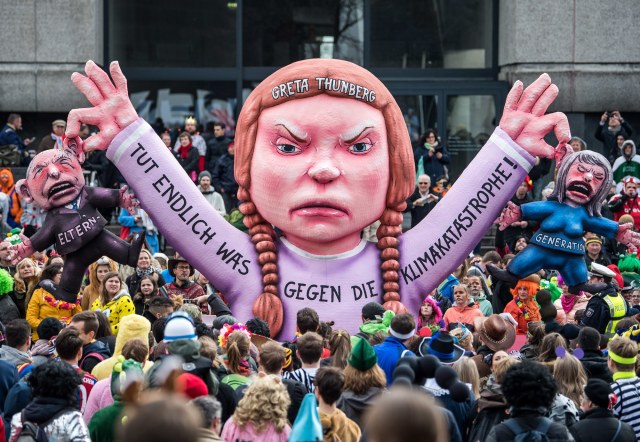Greta Thunberg, the 16-year-old Swedish environmental activist. Credit: Lukas Schulze/Getty Images

Prince Edward Island (PEI) is the smallest of Canada’s 10 provinces. It’s the Canadian equivalent of Rhode Island – except that it’s an actual island (in the Gulf of Saint Lawrence and roughly a quarter the size of Wales).
PEI’s 150,000 people don’t usually attract much attention. But today they go to the polls and might just become the first Province to elect a Green government.
It’s been a meteoric rise for the PEI Green Party, because just two years ago the pollsters had them on less than 10% of the vote.
But this is more than a Canadian curiosity. Though not quite as widespread as the populist surge, a Green wave is disrupting politics in countries across the West – and, as with the populists, it is the established parties of the centre-Left who are paying the price.
In the Netherlands, the main green party, GroenLinks, has replaced the once dominant Dutch Labour Party as the leading party of the Left. The German Greens may well follow suit – they are now regularly outpolling the SPD. In the Finnish general election last week, the Green League gained ground. In France, Les Verts are set to do better than the Socialists in the forthcoming Euro elections (though that’s not the highest of bars these days). The Australian Greens are now established as the third force in politics – though still some distance behind the big two. There’s no breaking the America duopoly, but radical green policies such as the Green New Deal are a big influence on the Democrats.
So why do we see Green support at rising and record levels in so many countries?
In an interview with the International Politics and Society journal, Zack Grant of Oxford University provides some of the answers. As part of a team that analysed “340 general election results in 32 countries… over the course of 45 years”, he found that green parties do best in countries with devolved political systems:
“Non-proportional electoral systems are often blamed for the woes of minor parties in countries. Overall, however, our study found decentralisation… to be a better predictor of Green party strength than the electoral system. Minor parties find it easier to win seats at the subnational level… these are typically second-order elections which are perceived as less important by voters, and therefore allow for greater chances of minor party success. Consequently, parties like the Greens can build reputations as credible legislators which aids future national election campaigns.”
Green electoral success is also associated with “high levels of GDP per capita and lower rates of unemployment”, “countries [that are] highly dependent on nuclear power” and “countries which lack substantial support for ‘radical Left’ parties such as Syriza and Podemos”.
Then there’s profound change in the demographic make-up of the Left-leaning electorate:
“…survey data analysis in many different countries consistently paints a similar picture with regard to who are the “core” Green voters: young, university-educated people working in ‘sociocultural’ areas (healthcare, social services, the arts etc.) that hold liberal social values.”
It’s not surprising that a completely different set of people has chosen a different set of parties to put their support behind.
Of course, Green parties haven’t prospered in every country. In the UK, the Greens have been overshadowed by Jeremy Corbyn and Momentum. As Zack Grant puts it, there’s “a degree of functional equivalency between certain Green parties and the radical left”.
It’s not just the radical Left, though. Other movements, most notably Emmanuel Macron’s En Marche, have been able to claim the young, urban, professional vote – and to do so from the centre or centre-Left (which, indeed, is where some Green parties position themselves).
In this age of insurgent Rightwing populism, it’s becoming clear that parties can prosper by presenting themselves as a counter-insurgency: seeking to provide an alternative to the political establishment, but diametrically opposing themselves to the national populists. Whereas the conventional parties of Left and Right seek to straddle the ‘Open-versus-Closed‘ divide (for instance on issues like immigration and EU integration), the populist and counter-populist parties are taking up positions at either end of the new spectrum.
I don’t expect the Open-versus-Closed agenda to entirely supplant Left-versus-Right, rather what we’re seeing is the rise of a messy and unstable four-cornered politics.
It’ll be made all the messier by the as yet unresolved contest between Greens, other parts of the anti-establishment Left, and liberal movements such as En Marche and Change UK to define the ‘Open’ politics of the next generation.
My money is on the Greens because, unlike the liberals, they’re not associated with establishment politics; and unlike the rest of the Left, they have don’t have to pay lip service to a working-class socialist tradition – and thus can focus their appeal to the college-educated, metropolitan voters most receptive to an ‘Open’ agenda.
Most importantly, Green parties can offer more than mere politics. As part of the wider environmental movement, they hold out the promise of purpose and belonging through a shared and value-laden lifestyle. For people with no other strong sense of identity that is a powerful offer – and, ironically, the one thing the Greens share with their populist opponents.










Join the discussion
Join like minded readers that support our journalism by becoming a paid subscriber
To join the discussion in the comments, become a paid subscriber.
Join like minded readers that support our journalism, read unlimited articles and enjoy other subscriber-only benefits.
Subscribe